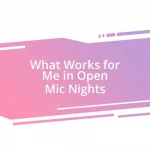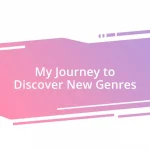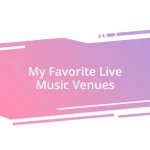Key takeaways:
- Understanding and connecting with the audience is essential for curating a successful live playlist; audience feedback helps tailor song selections in real-time.
- Choosing the right genre and considering demographics, time of day, and venue influences the overall vibe of the event.
- Incorporating emotionally impactful songs and personal stories creates deeper connections with the audience, enhancing their experience.
- Using streaming platforms for inspiration and engaging with the audience online helps in curating and promoting playlists effectively.

Understanding Your Audience
Understanding your audience is crucial for curating a live playlist that hits the right notes. I remember one time, I played a mix of indie and classic rock for a crowd, but it felt off. I quickly realized I had misread the room; they were craving upbeat pop hits instead. It’s a humbling reminder that, sometimes, even the best intentions can fall flat.
I often think about how people connect through music. Have you ever watched a crowd light up when a familiar song begins to play? That shared experience can transform a good playlist into a memorable event. Listening to whispers in the crowd can offer insights—are they swaying to the rhythm or chatting? Their reactions guide my next move, helping me tailor my selections to keep the energy flowing.
Empathy is at the heart of understanding your audience. I recall curating a playlist for a friend’s birthday party, and I made it a point to include songs that held special memories for her and our mutual friends. Seeing her reaction as those familiar tunes played—not just the joy, but the nostalgia—reminded me how powerful music can be in shaping our experiences together. By weaving in such personal threads, playlists become more than just background noise; they resonate deeply with people.

Choosing the Right Genre
Choosing the right genre can shape the entire vibe of your live playlist. I vividly remember a summer festival where I decided to go heavy on reggae. As the sun began to set, the laid-back grooves seemed perfect. Yet, I quickly noticed some folks were hoping for something more high-energy to match their excitement. It’s fascinating how the right genre can either elevate the atmosphere or create a disconnect.
- Start with the energy level: Are you aiming for a chill vibe or an upbeat dance party?
- Think about the crowd’s demographics: Age, culture, and preferences can guide your genre choices.
- Consider the time of day: Acoustic sets might work beautifully during sunset, while electrifying electronic beats can take over at night.
- Factor in the venue: An intimate coffee house may call for indie tracks, while an outdoor festival might need something more mainstream.
By keeping these aspects in mind, I can create playlists that not only align with the audience’s tastes but also enhance the overall experience of the event.

Selecting Songs for Impact
Selecting impactful songs is all about creating meaningful connections in the moment. One evening, I was curating a live set for an art gallery opening, and I chose a mix of atmospheric electronic tracks. As I watched people mingle, I noticed how certain melodies made their way into conversations, almost serving as a backdrop to their connections. That night, it struck me: the right song can enhance a fleeting moment, making it linger in the memory of both the listeners and the artist.
Another important aspect I consider is the emotional range of songs. My experience has taught me that the unexpected surprises can make a playlist truly memorable. One time, I incorporated a classic ballad right after a high-energy pop anthem, and it created a beautiful pause in the energy. People slowed down, some even swaying gently, and I caught glimpses of smiles, nostalgia, and even a few tears. It was a powerful reminder that music isn’t just entertainment; it’s a universal language that can evoke strong feelings.
To ensure my selections resonate, I often draw on personal stories tied to the songs themselves. For example, I once included a track that played during my college graduation. Sharing that story with my audience created an emotional anchor. When I watched people nod in recognition or lean in closer, I knew that I had woven a thread of shared experience into the fabric of the night. By infusing my personal connections with the music, I strive to not just play songs, but to evoke memories and foster a deeper emotional connection among everyone present.
| Selection Criteria | Examples |
|---|---|
| Emotional Impact | Classic ballads or nostalgic tracks |
| Unexpected Juxtaposition | High-energy followed by a softer song |
| Personal Connection | Stories tied to specific tracks |

Using Platforms for Curation
Using platforms for curation opens up a world of possibilities. I often find myself diving deep into music streaming services like Spotify or Apple Music, as they offer curated playlists that can inspire my selections. I remember stumbling upon a themed playlist filled with 90s hits while preparing for a retro-themed event, and it sparked my creativity. How often do we overlook these resources that can guide our curation process?
Once I’ve found a playlist that resonates, I personalize it further by mixing in tracks from various genres. One time, I added some indie rock tracks to an otherwise electronic playlist, creating a surprising and refreshing twist. The crowd’s reaction was instant; they were drawn into the experience as they heard unexpected sounds. It’s fascinating to see how the blend of curated platforms and slight modifications can elevate the entire playlist.
Engaging with the audience on these platforms also plays a critical role. I frequently check out the comments or reviews on the songs I’m considering. When I shared my thought process behind a song choice in a livestream, many viewers chimed in with their favorite tracks and stories from that era. It reminded me that this curation journey is not just about me; it’s about connecting with others and creating a shared musical experience. Isn’t it amazing how technology can help us foster these interactions?

Testing and Adjusting Your Playlist
Testing a playlist in a live setting is crucial, and I often find it helps to run a quick check before the event. I recall one instance when I played a new tracklist at a local café — about halfway through, I noticed people chatting less and tapping their feet more. That’s my cue; if the energy dips, it’s time for some adjustments. Isn’t it interesting how a subtle shift in rhythm can change the atmosphere?
One method I employ is to gauge the crowd’s reactions during the performance. As I tweak the order of songs, I pay close attention to the body language of my audience. I vividly remember leaving a high-energy song in my set and watching a few people start to lose interest. I quickly decided to pivot to a familiar classic, and the response was immediate: smiles returned, and feet began to dance again. This real-time feedback is an invaluable part of my curation process.
After events, I reflect on what worked and what didn’t by jotting down notes about the experience. This allows me to refine future playlists. For example, I once included a slow track that I thought would evoke emotion, but it fell flat. Analyzing why helps me avoid similar setbacks down the line. Don’t you think these adjustments make the art of curation all the more rewarding?

Promoting Your Live Playlist
Promoting my live playlist is as essential as the curation itself. I often tap into social media platforms to share sneak peeks of my set, like posting a short clip of a song that really resonates with my vibe. The excitement I feel when I see comments roll in, whether it’s someone expressing nostalgia or anticipation, is electric. Have you ever felt that thrill from engaging your audience before a show? It’s that shared energy that builds a deeper connection.
One strategy I find effective is creating engaging visuals, like eye-catching graphics for my upcoming events. I once designed a poster that featurd not only the playlist title but also colorful imagery reflecting the mood I wanted to create. The response was overwhelming! People started sharing it, and suddenly my playlist wasn’t just a local event; it became something people talked about. I believe that visuals can convey emotions that words sometimes can’t capture — don’t you think an attractive design can elevate the anticipation?
Networking with other musicians and influencers is another powerful way to promote my live playlist. I remember reaching out to a local band for a collaborative event, and they shared my playlist with their fans. The result was an incredible cross-pollination of audiences, and I gained new listeners in the process. This connection serves as a reminder that fostering community is key; we all rise together. How do you approach building connections in your music promotion journey?














